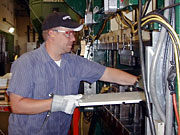|
Audio
Photos
Resources
Respond to this story
|
Whose recovery is it?
September 14, 2004
 |
| Depending on where you sit in the economy, "recovery" can mean many things -- or perhaps nothing at all. (MPR Photos/Jeff Horwich) |
St. Paul, Minn. — First the simple answer: The economic recovery belongs to all of us -- every American, and every Minnesotan.
After shrinking for eight months in 2001, the size of our national economy -- our Gross Domestic Product, or GDP -- has been growing since November of that year. And we all contribute in one way or another, every time we spend at the store or put in an honest day's work. Take it from Wells Fargo Chief Economist Sung Won Sohn.
"The economy is definitely expanding, recovering. We are seeing an economic growth rate in the range of 4 to 4.5 percent, significantly larger than the long-term potential economic growth rate," Sung said in a recent interview. "So yes, we do have economic expansion and GDP is telling us that we have (a recovery)."
 | |||
Since this conversation, we did learn that economic growth slowed this spring to more like three percent. It's what economists are calling a "soft patch" in the recovery. But it's not enough to change the overall verdict.
Along with economists, one more group is quick to herald the recovery: Politicians, at least those in power. This is Gov. Pawlenty, talking to National Public Radio this summer.
"In Minnesota it's a heck of a lot better than it was a year and a half ago," Pawlenty said. "Voters are starting to feel it. There's always a lag-time between the economic numbers economists talk about and it showing up in people's pocketbooks, but I think they're starting to feel it. And my sense, in talking to people, they recognize the economy is coming back."
The governor is right, but here's where the simple answer gets more complicated. In talking to people, you also hear this:
'Oh, we've turned the corner,' we hear a lot nowadays. We haven't turned any corner. Last time the recovery was much quicker."
"My compensation has been stagnant for the last four or five years, and I honestly feel that my benefits packages have gotten worse and worse."
"I'm not seeing the recovery part of it. I see things on the news about how everything's turning around, but I personally haven't really seen it yet."
The truth is, this recovery has been unusual in certain ways. Nearly three years on, there are still two job hunters in Minnesota for every one open position. Even as production grew, real hourly earnings fell over the past year. As you might expect, the economic recovery is very much in the eye of the beholder.
Part 2: "An almost two-tiered economy"
|
News Headlines
|
Related Subjects
|

